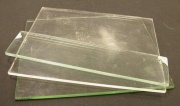Difference between revisions of "Plexiglas"
m (Text replace - "== Authority ==" to "== Sources Checked for Data in Record ==") |
m (Text replace - "\[http:\/\/cameo\.mfa\.org\/materials\/fullrecord\.asp\?name=([^\s]+)\s(.*)\]" to "$2") |
||
| Line 2: | Line 2: | ||
== Description == | == Description == | ||
| − | [Altuglas] A registered trademark for a transparent, thermoplastic [ | + | [Altuglas] A registered trademark for a transparent, thermoplastic [[acrylic%20sheet|acrylic sheet]]. Plexiglas® is composed of [[polymethyl%20methacrylate|polymethyl methacrylate]]. It was invented by Otto Rohm and Walter Bauer of Rohm and Haas in Darmstadt Germany. They coined the name [[plexiglass|plexiglass]] because it looked like [[glass|glass]] but could be heated and formed into many shapes. Rohm and Haas patented the product in 1933 and by 1936 was marketing the acrylic sheets under the name of Plexiglas® as a nonbreakable substitute for glass. The clear, lightweight material can be scratched easily and is marred by solvents. It also accumulates a static charge that attracts particles. Plexiglas® is used for signs, lens, containers, windows, skylights, windshields, protective glazing, chalkboards and furniture. Some types of Plexiglas® are: |
- UF-4: transmits less than 10% UV and does not have a yellow cast | - UF-4: transmits less than 10% UV and does not have a yellow cast | ||
Revision as of 11:23, 10 May 2016
Description
[Altuglas] A registered trademark for a transparent, thermoplastic Acrylic sheet. Plexiglas® is composed of Polymethyl methacrylate. It was invented by Otto Rohm and Walter Bauer of Rohm and Haas in Darmstadt Germany. They coined the name Plexiglass because it looked like Glass but could be heated and formed into many shapes. Rohm and Haas patented the product in 1933 and by 1936 was marketing the acrylic sheets under the name of Plexiglas® as a nonbreakable substitute for glass. The clear, lightweight material can be scratched easily and is marred by solvents. It also accumulates a static charge that attracts particles. Plexiglas® is used for signs, lens, containers, windows, skylights, windshields, protective glazing, chalkboards and furniture. Some types of Plexiglas® are:
- UF-4: transmits less than 10% UV and does not have a yellow cast
- UF-3: transmits less than 2% UV and has a slight yellow cast
- (OP-2) 201: colorless UV absorbing sheet
Synonyms and Related Terms
PMMA; polymethylmethacrylate; polimetilmetacrilato (Esp.); Lucite® [Lucite]; Perspex® [Lucite); Plexiglas® [Arkema]; Altuglas® [Arkema]; Acrylite® [Piedmont Plastics]
Additional Information
Altuglas: Plexiglas Website
Sources Checked for Data in Record
- External source or communication Comment: submitted information: James Harwood, University of Akron, September 2008.
- G.S.Brady, Materials Handbook, McGraw-Hill Book Co., New York, 1971 Comment: p. 11
- The American Heritage Dictionary or Encarta, via Microsoft Bookshelf 98, Microsoft Corp., 1998
- Dictionary of Building Preservation, Ward Bucher, ed., John Wiley & Sons, Inc., New York City, 1996
- Ralph Mayer, A Dictionary of Art Terms and Techniques, Harper and Row Publishers, New York, 1969 (also 1945 printing)
- Hermann Kuhn, Conservation and Restoration of Works of Art and Antiquities, Butterworths, London, 1986
- Thomas C. Jester (ed.), Twentieth-Century Building Materials, McGraw-Hill Companies, Washington DC, 1995
- Book and Paper Group, Paper Conservation Catalog, AIC, 1984, 1989
- Marie Svoboda, Conservation Survey Index, unpublished, 1997
- Teri Hensick, contributed information, 1998
- Website address 1 Comment: www.rohmhaas.com/company/history
